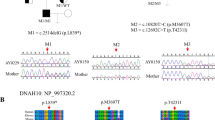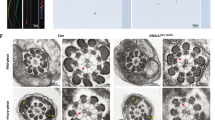Abstract
Background
Asthenoteratospermia with multiple morphological abnormalities in the sperm flagella (MMAF) is a significant cause of male infertility. WDR19 is a core component in the IFT-A complex and has a critical role in intraflagellar transport. However, the role of WDR19 mutations in male infertility has yet to be examined.
Methods and results
We performed whole exome sequencing (WES) for 65 asthenoteratospermia individuals and identified a proband who carried a homozygous WDR19 (c.A3811G, p.K1271E) mutation from a consanguineous family. Systematic examinations, including CT scanning and retinal imaging, excluded previous ciliopathic syndromes in the proband. Moreover, semen analysis of this patient showed that the progressive rate decreased to zero, and the sperm flagella showed multiple morphological abnormalities. Scanning and transmission electron microscopy assays indicated that the ultrastructure of sperm flagella in the patient was completely destroyed, while immunofluorescence revealed that WDR19 was absent from the sperm neck and flagella. Moreover, IFT140 and IFT88, predicted to interact with WDR19 directly, were mis-allocated in the WDR19-mutated sperm. Notably, the MMAF subject harboring WDR19 variant and his partner successfully achieved clinical pregnancy through intracytoplasmic sperm injection (ICSI).
Conclusions
We identified WDR19 as a novel pathogenic gene for male infertility caused by asthenoteratospermia in the absence of other ciliopathic phenotypes, and that patients carrying WDR19 variant can have favorable pregnancy outcomes following ICSI.



Similar content being viewed by others
References
Baccetti B, Collodel G, Estenoz M, Manca D, Moretti E, Piomboni P. Gene deletions in an infertile man with sperm fibrous sheath dysplasia. Hum Reprod. 2005;20(10):2790–4.
Pedersen LB, Rosenbaum JL. Intraflagellar transport (IFT) role in ciliary assembly, resorption and signalling. Curr Top Dev Biol. 2008;85:23–61.
Buisson J, Chenouard N, Lagache T, Blisnick T, Olivo-Marin JC, Bastin P. Intraflagellar transport proteins cycle between the flagellum and its base. J Cell Sci. 2013;126(Pt 1):327–38.
Efimenko E, Blacque OE, Ou G, Haycraft CJ, Yoder BK, Scholey JM, et al. Caenorhabditis elegans DYF-2, an orthologue of human WDR19, is a component of the intraflagellar transport machinery in sensory cilia. Mol Biol Cell. 2006;17(11):4801–11.
Cooper TG, Noonan E, von Eckardstein S, Auger J, Baker HW, Behre HM, et al. World Health Organization reference values for human semen characteristics. Hum Reprod Update. 2010;16(3):231–45.
He X, Li W, Wu H, Lv M, Liu W, Liu C, et al. Novel homozygous CFAP69 mutations in humans and mice cause severe asthenoteratospermia with multiple morphological abnormalities of the sperm flagella. J Med Genet. 2019;56(2):96–103.
Liu W, He X, Yang S, Zouari R, Wang J, Wu H, et al. Bi-allelic mutations in TTC21A induce asthenoteratospermia in humans and mice. Am J Hum Genet. 2019;104(4):738–48.
Auger J, Jouannet P, Eustache F. Another look at human sperm morphology. Hum Reprod. 2016;31(1):10–23.
Liu H, Li W, Zhang Y, Zhang Z, Shang X, Zhang L, et al. IFT25, an intraflagellar transporter protein dispensable for ciliogenesis in somatic cells, is essential for sperm flagella formation. Biol Reprod. 2017;96(5):993–1006.
Zhang Y, Liu H, Li W, Zhang Z, Shang X, Zhang D, et al. Intraflagellar transporter protein (IFT27), an IFT25 binding partner, is essential for male fertility and spermiogenesis in mice. Dev Biol. 2017;432(1):125–39.
Liem KF Jr, Ashe A, He M, Satir P, Moran J, Beier D, et al. The IFT-A complex regulates Shh signaling through cilia structure and membrane protein trafficking. J Cell Biol. 2012;197(6):789–800.
Fath MA, Mullins RF, Searby C, Nishimura DY, Wei J, Rahmouni K, et al. Mkks-null mice have a phenotype resembling Bardet-Biedl syndrome. Hum Mol Genet. 2005;14(9):1109–18.
Mykytyn K, Mullins RF, Andrews M, Chiang AP, Swiderski RE, Yang B, et al. Bardet-Biedl syndrome type 4 (BBS4)-null mice implicate Bbs4 in flagella formation but not global cilia assembly. Proc Natl Acad Sci U S A. 2004;101(23):8664–9.
Nishimura DY, Fath M, Mullins RF, Searby C, Andrews M, Davis R, et al. Bbs2-null mice have neurosensory deficits, a defect in social dominance, and retinopathy associated with mislocalization of rhodopsin. Proc Natl Acad Sci U S A. 2004;101(47):16588–93.
Thiel C, Kessler K, Giessl A, Dimmler A, Shalev SA, von der Haar S, et al. NEK1 mutations cause short-rib polydactyly syndrome type Majewski. Am J Hum Genet. 2011;88(1):106–14.
Badano JL, Leitch CC, Ansley SJ, May-Simera H, Lawson S, Lewis RA, et al. Dissection of epistasis in oligogenic Bardet-Biedl syndrome. Nature. 2006;439(7074):326–30.
Hoefele J, Wolf MT, O’Toole JF, Otto EA, Schultheiss U, Deschenes G, et al. Evidence of oligogenic inheritance in nephronophthisis. J Am Soc Nephrol. 2007;18(10):2789–95.
Palermo G, Joris H, Devroey P, Van Steirteghem AC. Pregnancies after intracytoplasmic injection of single spermatozoon into an oocyte. Lancet. 1992;340(8810):17–8.
Chemes HE, Alvarez SC. Tales of the tail and sperm head aches: changing concepts on the prognostic significance of sperm pathologies affecting the head, neck and tail. Asian J Androl. 2012;14(1):14–23.
Wambergue C, Zouari R, Fourati Ben Mustapha S, Martinez G, Devillard F, Hennebicq S, et al. Patients with multiple morphological abnormalities of the sperm flagella due to DNAH1 mutations have a good prognosis following intracytoplasmic sperm injection. Hum Reprod 2016;31(6):1164–1172.
Zhu F, Wang F, Yang X, Zhang J, Wu H, Zhang Z, et al. Biallelic SUN5 mutations cause autosomal-recessive acephalic spermatozoa syndrome. Am J Hum Genet. 2016;99(4):942–9.
Sha YW, Xu X, Mei LB, Li P, Su ZY, He XQ, et al. A homozygous CEP135 mutation is associated with multiple morphological abnormalities of the sperm flagella (MMAF). Gene. 2017;633:48–53.
Acknowledgments
We would like to thank the families who participated in and supported this research.
Authors’ Contributors
YC, FZ, XH, and XN designed the study. XN, JW, YZ, HW, YG, QT, BC, QL, BS, ZW, and ZZ provided patients’ data and performed clinical assessments. XN, ML, JW, ST, CL, HC, YG, YC, and QT conducted the experiments. XN, XH, ML, ST, and JW analyzed the data. XN and XH wrote the manuscript. YC, FZ, and XH were responsible for the study supervision. All authors read and approved the final manuscript.
Funding
This study was supported by the Special Foundation for Development of Science and Technology of Anhui Province (grant number 2017070802D150), the Natural Science Foundation of Anhui Province (grant numbers 1708085QC59 and 1908085QH313), the Non-profit Central Research Institute Fund of Chinese Academy of Medical Sciences (2019PT310002), and the University Synergy Innovation Program of Anhui Province (GXXT-2019-044).
Author information
Authors and Affiliations
Corresponding authors
Ethics declarations
Competing interests
The authors declare that they have no competing interests.
Patient consent
All patients provided their signed informed consent for this study.
Provenance and peer review
Not commissioned; externally peer reviewed.
Data sharing statement
Additional unpublished data.
Ethics approval
The Ethical Committee of Anhui Medical University (PJ2017-11-10).
Additional information
Publisher’s note
Springer Nature remains neutral with regard to jurisdictional claims in published maps and institutional affiliations.
Rights and permissions
About this article
Cite this article
Ni, X., Wang, J., Lv, M. et al. A novel homozygous mutation in WDR19 induces disorganization of microtubules in sperm flagella and nonsyndromic asthenoteratospermia. J Assist Reprod Genet 37, 1431–1439 (2020). https://doi.org/10.1007/s10815-020-01770-1
Received:
Accepted:
Published:
Issue Date:
DOI: https://doi.org/10.1007/s10815-020-01770-1




